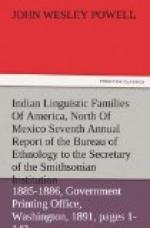TANOAN FAMILY.
> Tay-waugh, Lane (1854) in Schoolcraft, Ind. Tribes, V. 689, 1855 (Pueblos of San Juan, Santa Clara, Pojuaque, Nambe. San Il de Conso, and one Moqui pueblo). Keane, App. Stanford’s Comp. (Cent, and So. Am.), 479, 1878.
> Tano, Powell in Rocky Mountain Presbyterian,
Nov., 1878 (includes
Sandia, Tewa, San Ildefonso, San Juan,
Santa Clara, Pojoaque, Nambe,
Tesuque, Sinecu, Jemez, Taos, Picuri).
> Tegna, Keane, App. Stanford’s
Comp. (Cent, and So. Am.), 479, 1878
(includes S. Juan, Sta. Clara, Pojuaque,
Nambe, Tesugue, S. Ildefonso,
Haro).
= Tewan, Powell in Am. Nat., 605, Aug., 1880 (makes five divisions: 1. Tano (Isleta, Isleta near El Paso, Sandia); 2. Taos (Taos, Picuni); 3. Jemes (Jemes); 4. Tewa or Tehua (San Ildefonso, San Juan, Pojoaque, Nambe, Tesuque, Santa Clara, and one Moki pueblo); 5. Piro).
> E-nagh-magh, Lane (1854) in Schoolcraft, Ind. Tribes, V, 689, 1855 (includes Taos, Vicuris, Zesuqua, Sandia, Ystete, and two pueblos near El Paso, Texas). Keane, App. Stanford’s Comp. (Cent, and So. Am.), 479, 1878 (follows Lane, but identifies Texan pueblos with Lentis? and Socorro?).
> Picori, Keane, App. Stanford’s
Comp. (Cent, and So. Am.), 479, 1878
(or Enaghmagh).
= Stock of Rio Grande Pueblos, Gatschet
in U.S. Geog. Surv. W. 100th
M., vii, 415, 1879.
= Rio Grande Pueblo, Gatschet in Mag. Am. Hist., 258, 1882.
Derivation: Probably from “tainin,” plural of ta-ide, “Indian,” in the dialect of Isleta and Sandia (Gatschet).
In a letter[97] from Wm. Carr Lane to H. R. Schoolcraft, appear some remarks on the affinities of the Pueblo languages, based in large part on hearsay evidence. No vocabularies are given, nor does any real classification appear to be attempted, though referring to such of his remarks as apply in the present connection, Lane states that the Indians of “Taos, Vicuris, Zesuqua, Sandia, and Ystete, and of two pueblos of Texas, near El Paso, are said to speak the same language, which I have heard called E-nagh-magh,” and that the Indians of “San Juan, Santa Clara, Pojuaque, Nambe, San Il de Conso, and one Moqui pueblo, all speak the same language, as it is said: this I have heard called Tay-waugh.” The ambiguous nature of his reference to these pueblos is apparent from the above quotation.
[Footnote 97: Schoolcraft, Indian Tribes, 1855, vol. 5, p. 689.]
The names given by Lane as those he had “heard” applied to certain groups of pueblos which “it is said” speak the same language, rest on too slender a basis for serious consideration in a classificatory sense.
Keane in the appendix to Stanford’s Compendium (Central and South America), 1878, p. 479, presents the list given by Lane, correcting his spelling in some cases and adding the name of the Tusayan pueblo as Haro (Hano). He gives the group no formal family name, though they are classed together as speaking “Tegua or Tay-waugh.”




